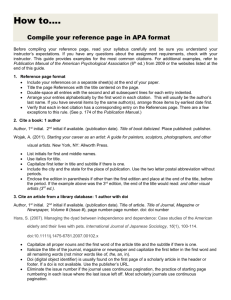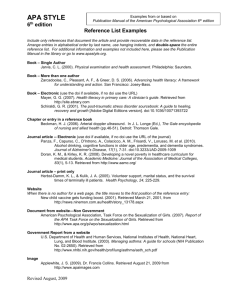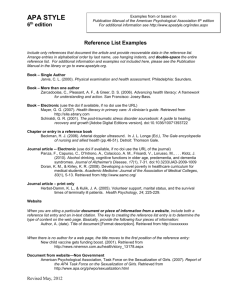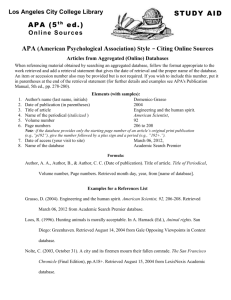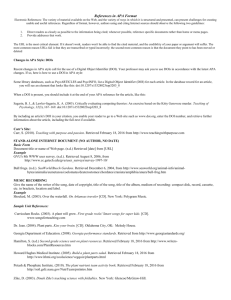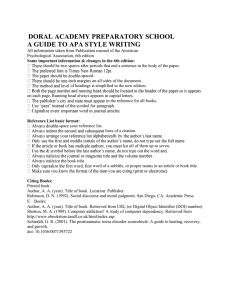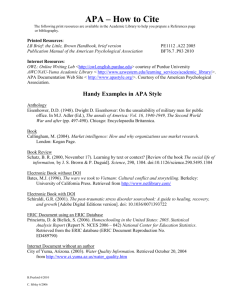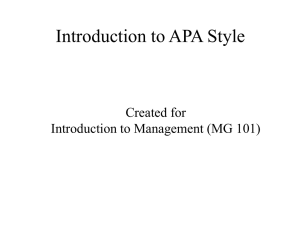Your Guide to the Magic and Mystery of APA Style
advertisement
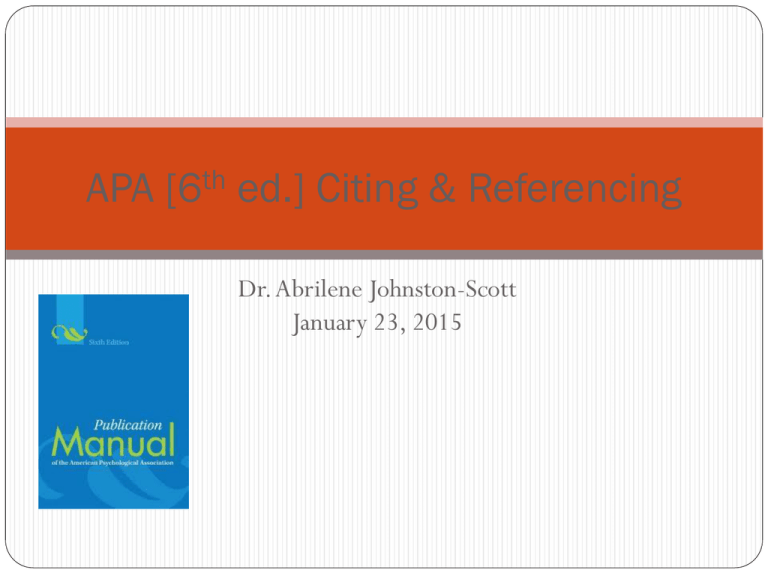
APA [6th ed.] Citing & Referencing Dr. Abrilene Johnston-Scott January 23, 2015 Why are you required use APA style? Because learning to write means mastering an accepted and uniform writing style. Because APA style is the most common writing style in the Social Sciences and is used by BMC. What’s Included in APA Style? Basically, everything in your paper: - How you format your pages How you cite sources How you list your references Even your language Today we will be concentrating on Citing, Referencing and Formatting research paper We’ll start with the list of references Required if you cite any sources in your paper Every source cited in your paper must appear on the reference list, and every entry in your reference list must be cited in your paper Your reference list should be double spaced between sources or entries and single spaced between lines! Single-authored book Format: Author, A. A. (Date of publication). Title of book. Publisher Address: Publisher. Perloff, R. M. (1995). The dynamics of persuasion. Hillsdale, NJ: Erlbaum. Dual-authored book Baran, S. J., & Davis, D. K. (1995). Mass communication theory: Foundations, ferment and future. Belmont, CA: Wadsworth. *Note: when listing authors, use an ampersand (&) in the reference list, not “and.” Single-Authored Journal Article Garramone, G. M. (1985). Effects of negative political advertising: The roles of sponsor and rebuttal. Journal of Broadcasting & Electronic Media, 29, 149-159. *Note: The first letter of every important word in the title of the journal is capitalized. Internet articles based on a print source VandenBos, G., Knapp, S., & Doe, J. (2001). Role of reference elements in the selection of resources by psychology undergraduates. [Electronic version]. Journal of Bibliographic Research, 5, 117-123. *Note: Sometimes electronic versions are different from the print versions. Article from an Online Periodical Online articles follow the same guidelines for printed articles. Include all information the online host makes available, including an issue number in parentheses. Format: Author, A. A., & Author, B. B. (Date of publication). Title of article. Title of Online Periodical, volume number(issue number if available). Retrieved from http://www.someaddress.com/full/url/ Example: Bernstein, M. (2002). 10 tips on writing the living Web. A list apart: For people who make websites, 149. Retrieved from http://www.alistapart.com/articles/writeliving Article From an Online Periodical with DOI Assigned Format: Author, A. A., & Author, B. B. (Date of publication). Title of article. Title of Journal, volume number, page range. doi:0000000/000000000000 or http://dx.doi.org/10.0000/0000 Examples: Brownlie, D. (2007). Toward effective poster presentations: An annotated bibliography. European Journal of Marketing, 41, 1245-1283. doi:10.1108/03090560710821161 Wooldridge, M.B., & Shapka, J. (2012). Playing with technology: Mother- toddler interaction scores lower during play with electronic toys. Journal of Applied Developmental Psychology, 33(5), 211-218. http://dx.doi.org/10.1016/j.appdev.2012.05.005 Article From an Online Periodical with no DOI Assigned Note: Online scholarly journal articles without a DOI require the URL of the journal home page. Remember that one goal of citations is to provide your readers with enough information to find the article; providing the journal home page aids readers in this process. Format: Author, A. A., & Author, B. B. (Date of publication). Title of article. Title of Journal, volume number. Retrieved from http://www.journalhomepage.com/full/url/ Example: Kenneth, I. A. (2000). A Buddhist response to the nature of human rights. Journal of Buddhist Ethics, 8. Retrieved from http://www.cac.psu.edu/jbe/twocont.html Journal Article From a Database Format: Author, A. A., & Author, B. B. (Date of publication). Title of article. Title of Journal, volume number, page range. Example: Smyth, A. M., Parker, A. L., & Pease, D. L. (2002). A study of enjoyment of peas. Journal of Abnormal Eating, 8(3), 120-125. Abstract Note: If you only cite an abstract but the full text of the article is also available, cite the online abstract as any other online citations, adding "[Abstract]" after the article or source name. However, if the full text is not available, you may use an abstract that is available through an abstracts database as a secondary source. Format: Paterson, P. (2008). How well do young offenders with Asperger Syndrome cope in custody?: Two prison case studies [Abstract]. British Journal of Learning Disabilities, 36(1), 54-58. Example: Hendricks, J., Applebaum, R., & Kunkel, S. (2010). A world apart? Briding the gap between theory and applied social gerontology. Gerontologist, 50(3), 284293. Newspaper Article Format: Author, A. A. (Year, Month Day). Title of article. Title of Newspaper. Retrieved from http://www.someaddress.com/full/url/ Example: Parker-Pope, T. (2008, May 6). Psychiatry handbook linked to drug industry. The NewYork Times. Retrieved from http://well.blogs.nytimes.com/2008/05/06/psychiatryhandbook-linked-to-drug-industry/ Electronic Books Example: De Huff, E. W. (n.d.). Taytay’s tales:Traditional Pueblo Indian tales. Retrieved from http://digital.library.upenn.edu/women/dehuff/taytay/taytay.ht ml Online Encyclopedias and Dictionaries Often encyclopedias and dictionaries do not provide bylines (authors' names). When no byline is present, move the entry name to the front of the citation. Provide publication dates if present or specify (n.d.) if no date is present in the entry. Feminism. (n.d.). In Encyclopædia Britannica online. Retrieved from http://www.britannica.com/EBchecked/topic/724633/feminis m When do you cite your sources in your paper? When you’re using an idea or concept from a source. When you quote from a source. Citing when paraphrasing List the last names of all authors the first time you cite them, unless there are more than 5. If there are more than five, or you are citing the paper of 3 or more authors for a second or more time, list last name of first author, followed by “et al.,” and the date. Citing when quoting You need to put the author last name(s) and date, like when paraphrasing, but also the PAGE NUMBERS or PARAGRAPH NUMBERS. Example: “the research findings clearly indicate support for the hypotheses” (Douglass, 1986, p. 55). Warning Keep quotations to a minimum (less than 3 per paper). Don’t forget the quotation marks and page numbers (or paragraph numbers), or you will be guilty of plagiarism! Include no more than 40 words in each quotation. Formatting your paper Double line spaced throughout Indent first line in each paragraph Font size 12 throughout the paper Font style Times New Roman Bold all headings Reference page starts on a new page No white spaces in the body of the paper One inch margin all around APA formatted Title Page ( a common Title Page) Proposing a Common APA Formatted Title Page Running head Title of Assignment Student’s Name Student’s Number Course Name and Number Lecturer’s Name Date Conclusion This concludes my presentation. Questions?


